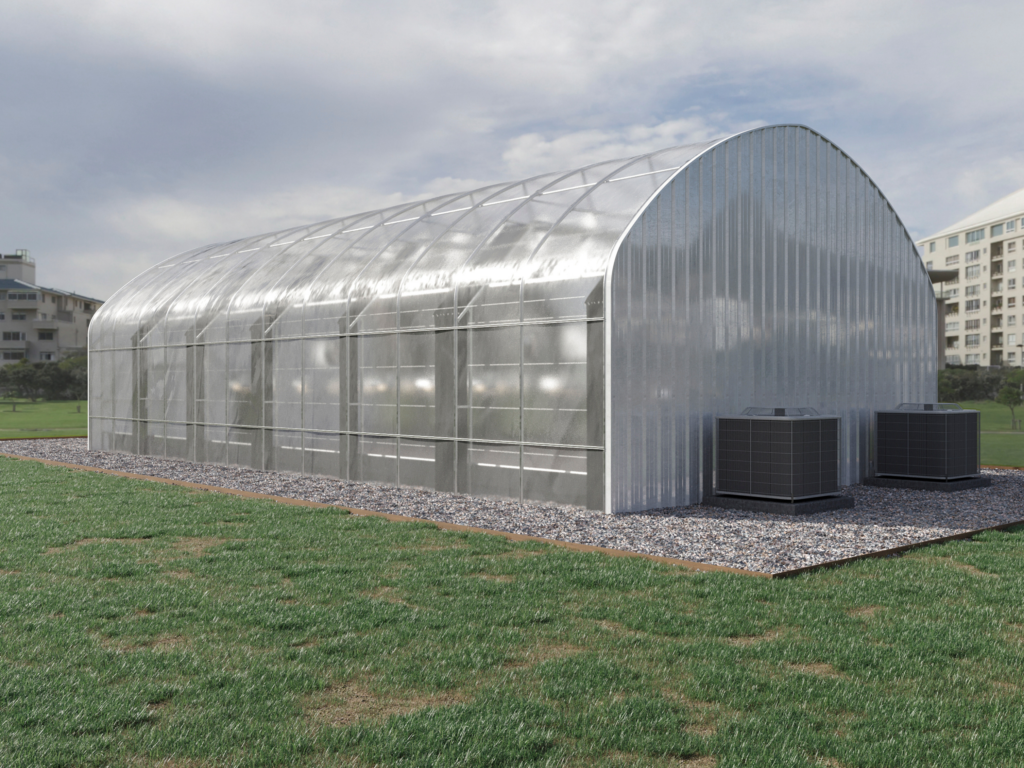Many hobby growers and horticultural enthusiasts dream of having a greenhouse to grow plants year-round in a controlled environment. Greenhouses provide a relatively consistent environment and frankly, most plants tend to flourish under the hot, humid environments protected from the wind, rain, or snow. Though the structure itself can be relatively simple in design, there are some factors of constructing or buying your own greenhouse that can be quite overwhelming, including factoring in the cost of heating and cooling a greenhouse. The costs of both equipment and operating heating and cooling systems can add up quickly, and often become a limiting factor in the size of your structure. It is important to factor in both the type of greenhouse you are building, along with the climate you live in when designing a heating or cooling system for your growing environment. One of the main components of heat loss and cooling ability is the actual covering material on your greenhouse.

The type and thickness of your greenhouse covering can greatly influence the amount of heat required to maintain growing conditions in colder seasons. Coverings often are described by their R-values, which is a value used to quantify the loss of heat through a layer of insulating material. Traditional greenhouses used glass pane coverings, but due to the high cost, low insulating value, and low strength compared to modern materials glass has become antiquated in the greenhouse industry and many growers have switched to polycarbonate panels, acrylic panels, or polyethylene film to cover their structure. Single pane glass has an incredibly low R-value, so to be as efficient as modern plastics growers require double or triple pane glass which carries a remarkably high price tag. Furthermore, glass is very fragile under extreme weather conditions and can be destroyed by hail. Small glass greenhouses in research settings are still common, but often use tempered glass that is bent in place to create tension across the glass that adds strength.

Polycarbonate Panels
Polycarbonate panels are the strongest option for greenhouse coverings and have a remarkably high R-value compared to other greenhouse coverings. Polycarbonate is available in single to 5-wall panels that provide a significant amount of insulation at the expense of a reduced light level with each increased layer.
Polycarbonate panels come at a higher cost than other coverings, but often pay themselves off with how long they last combined with reduced heating costs. These panels are stiff and normally need to be fixed to a flat surface using screws and rubber washers. These panels are not ideal for hoop style greenhouses and are more suited to permanent structures and true steel frames. Polycarbonate panels also come in a variety of light dispersion options, ranging from clear to opal to disperse light and reduce heat. Some options such as the Solexx panel come coated with UV dispersion films to reduce heat in the greenhouse while providing high quality light.

Acrylic Sheets
Acrylic sheets are another option for permanent structures, especially in areas with lower light conditions. This is because acrylic transmits much more light than polycarbonate (92% vs. 88% in Polycarbonate) but is much less flexible and is not as impact resistant. Acrylic can also be much more expensive, so it is only recommended when light levels are of the utmost importance. Because of how stiff Acrylic is, it can not be used on any structure with a rounded shape, and most be confined to flat surfaces.

Polyethylene Film
Polyethylene film, or commonly referred to as “greenhouse poly” is one of the most cost-effective and accessible greenhouse coverings on the market. Greenhouse poly is often sold in rolls of varying widths or cut to custom size and can be handled similarly to vapor barrier. Many growers make the mistake of using construction vapor barrier, but this product is not UV stabilized and will degrade quickly leaving holes in your greenhouse covering within 1 season. Greenhouse poly also comes woven, which means the strands of polyethylene are crossed in manufacturing so that if there is a puncture, the film is less likely to tear or continue tearing from the hole. This film comes in varying thicknesses from 4-11mm has varying lifespans and R-values though common expected lifespan from poly is 5-7 years on a greenhouse structure.

Greenhouse poly is normally pulled over the purlins of a greenhouse structure and then secured tightly with “Wiggle Wire” or “Wire Lock” to the greenhouse frame. This process makes changing and replacing sections of the film easy with a few individuals and requires virtually no tools or special equipment once set up. It is common to have 2 layers of this greenhouse poly on a structure, then inflate the space in between the 2 layers with an inflator fan. This gap of air provides significant insulation and provides pressure against the outside plastic that increases impact resistance and turgidity of the plastic in windy conditions. These types of coverings can also incorporate roll-up sides which is an inexpensive way to incorporate ventilation into your greenhouse.

To learn more about wiggle wire, greenhouse poly, or inflator fans check out this blog post and video:
https://zipgrow.com/wiggle-wire-and-double-layer-greenhouses/






